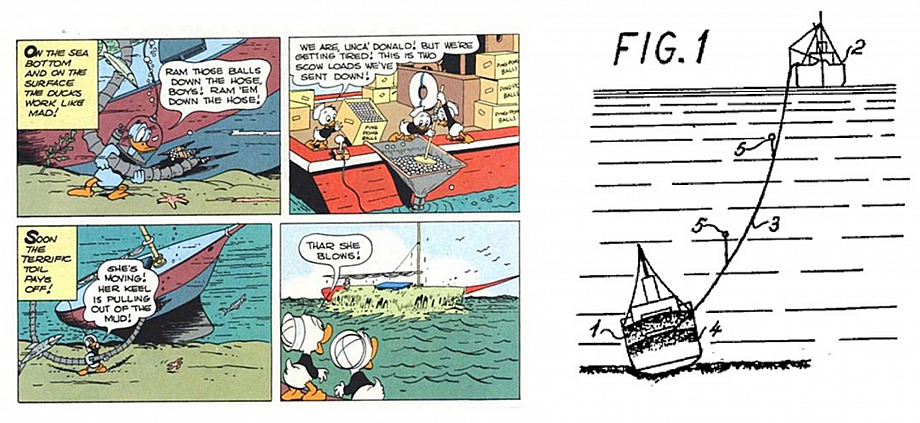Prior Art Gone Wild

Donald Duck as a Patent Killer
Imagine you spend months perfecting a ship-raising method, dutifully file your patent application… only to have the examiner wave around a Donald Duck comic from 1949. Sounds absurd, but in patent circles, the story has been told for decades. According to the popular tale, the Dutch application NL 6514306 was dismissed because Carl Barks’s story “The Sunken Yacht” was deemed to destroy novelty. In that comic, Donald and his nephews pump ping-pong balls into a sunken ship to lift it back to the surface.
That very technique was actually used by Danish inventor Karl Krøyer in 1964, when he refloated a capsized cargo ship in Kuwait with millions of plastic balls. Although he secured patents for his method in Germany, the UK, and elsewhere, the Dutch application was (at least according to patent legends), thrown out because of the earlier published comic. Official records citing the Donald Duck strip as prior art have never been found, but the anecdote grew into the classic example that truly anything can count as prior art. In the patent world, Donald Duck is not just an innocent duck, but a duck with legally razor-sharp teeth.

Prior Art Unmasked: What Counts?
Why can an apparently childish source be potentially fatal? Because Article 54(2) EPC flatly states that the state of the art “means everything made available to the public before the filing or priority date.” So it’s not just patents and scientific papers that count, but also blogs, tweets, YouTube videos, museum brochures, posters, and even comics and feature films. If a skilled reader could pull the same technical details from any of those sources before your date, you lose your absolute novelty.
And that novelty isn’t a minor point: it’s a must‐have if you want a patent. Without novelty, meaning your invention has already been (publicly) described, your application cannot be granted.
Don’t assume only recent sources matter: even prehistoric cave paintings or ancient manuscripts could, in theory, destroy novelty, as long as they’re technically relevant and were accessible before your date.
Borat in a Bikini – Prior Kazakhstan!
If you think only cartoons are dangerous, you haven’t met Sacha Baron Cohen’s fluorescent green mankini. In 2008, a U.S. patent application for a “scrotal support garment” was filed, and then rejected. By legend, the USPTO examiner pointed to stills from the film Borat: Cultural Learnings of America for Make Benefit Glorious Nation of Kazakhstan (2006), arguing that the mankini in the movie shows the same technical features as the claimed garment.

Steve Jobs’s Keynote – Prior Art from Your Own House
Not only comics or films, but also speeches and presentations can prove fatal to a patent application. Apple learned this the hard way with their famous “rubber-banding” effect—the spring-back animation you see when you scroll too far on an iPhone.
Why? A video of Steve Jobs’s iPhone keynote from January 2007, in which he demonstrated that bounce-back effect, was publicly accessible worldwide before the patent’s filing date. As a result, the demonstration qualified as prior art. The court found that several claims were therefore not novel. Apple tried to defend itself on technical grounds, arguing that their patented implementation differed, but in the end only three of the twenty claims were upheld. A painful example of how prior art can lurk even in your own marketing materials.
Grandma Wapsie – The Grandma Who Beat a Patent with a Cookie Recipe
Meet Grandma Wapsie, real name Rita, from a small town in the Netherlands. Back in 2002, she shared a simple recipe on her website: crushed Biscoff cookies mixed with butter. It was something her mother used to make after World War II. Rita never thought much of it. She wasn’t trying to invent anything, just sharing an old family recipe online.
But a few years later, Biscoff Spread became a big hit in Belgium. Two inventors got a patent for it after showing it on a TV show. Soon, companies like Lotus Bakeries got involved in legal fights over who had the rights. That’s when someone from Lotus emailed Rita to ask about her recipe. She answered his questions… and then never heard from him again. All she got was a box of cookies and a few jars of Biscoff Spread.
Even though no judge officially said she was the real inventor, her old blog post may have helped prove that the recipe wasn’t new, and that means the patent wasn’t valid. Meanwhile, Grandma Wapsie didn’t make a single euro from it. “Everyone’s getting rich from this,” she said, “except me.”
The lesson? Before you patent your big idea, check if someone’s grandma has already posted it online.
Patent Searching: Between Seriousness and Absurdity
These examples sharply illustrate why patent searching must be taken seriously. Big companies spend fortunes on thorough prior-art investigations to avoid unwelcome surprises. Patent attorneys comb through databases, visit trade shows, and yes, even leaf through comic books and film archives.
Time and again, prior art turns up in the most unexpected places. Whether it’s Donald Duck, Borat in a mankini, or a Steve Jobs keynote, or a grandmother’s nostalgic recipe, innovation often teeters on the border between brilliance and absurdity. And that’s exactly what makes the patent system so compelling, challenging, and sometimes downright frustrating.
So you’ve got a brilliant idea? Don’t just think about labs and technical reports. You might also want to check your bookshelf, your Netflix queue, or your old DVD collection. You never know which unlikely source has already beaten you to it.
Do you have a question?
We would be happy to assist you.
Make an appointment with one of our experts.
Rest assured, you're not alone.
Feel free to browse through the FAQ and don't hesitate to
contact us if you still have any doubts.




